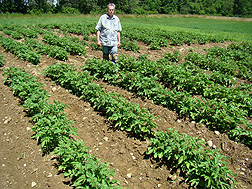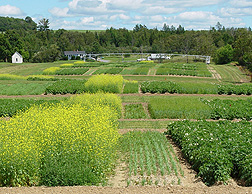Multiple Prospects for Maine’s Potato Producers
|
|
Given all the pathogens that can create havoc in a potato field, it’s a wonder spud production can keep up with demand. Producers need to control these microbes with cost-efficient management strategies that also promote soil quality and farm profits.
“Potato production is a tillage-intensive system that’s very hard on soils,” says plant pathologist Bob Larkin.
At the New England Plant, Soil, and Water Research Laboratory in Orono, Maine, Larkin and his colleagues have been conducting studies that investigate potato production from almost every angle they can find. Their results have been published in almost a dozen papers and provide valuable guidance to farmers who want to keep Maine among the top 10 states in potato production.
“We’re looking for improvements we can obtain through cultural practices,” says Larkin. “We started with different crop-management practices, like using different rotations and cover crops with potato, and adding disease-suppressive crops and soil amendments. Then we tested different practices within the cropping systems. Each practice may have a small but significant effect, so we want to see how we can combine them to obtain multiple strategies that provide cumulative beneficial effects.”
Larkin had three clear objectives in mind—reducing disease, increasing yields, and increasing production sustainability—and he knew that no single practice could accomplish all three goals. So he began working with Orono agricultural economist John Halloran and others to test strategies using cover crops, rotation schedules, soil amendments, and irrigation.
|
|
Potato Patches in Progress
In one study, the scientists investigated how eight different 3-year cropping systems, which included potato as the third crop in the rotation, affected soil microbes. In another study, the scientists examined how “green manure”—that is, a cover crop that is plowed into the soil—affected the activity of soilborne potato pathogens. In a third study, the team examined how assorted biological amendments affected beneficial soil microorganisms and reduced soilborne potato diseases. The amendments included commercial biocontrol agents, microbial inoculants, mycorrhizae, and aerobic compost tea.
Larkin’s team included some of this work as a component of another 10-year study to see how seven different 2-year rotations affected the development of soilborne potato diseases, tuber yield, and soil microbial communities. The team also assessed the effects of these same rotations with and without a fall cover crop of no-till winter rye over a 4-year period.
From the extensive data they gathered in the studies, the scientists developed some very clear recommendations for Maine potato producers.
“In general, 3-year crop rotations, as opposed to the 2-year rotations typically used, help break the host-pathogen cycle,” says Larkin. “We found that 3-year rotations provide better disease control and higher crop yields. These rotations also help support beneficial soil microbes that improve soil quality by increasing soil organic matter or by inhibiting plant pathogens.”
Larkin’s team has looked extensively at potential disease-suppressive rotation crops, such as Brassica (canola, rapeseed, and mustard) and sudangrass cover crops. The scientists observed that in general, using mustard as a green manure reduced the incidence of powdery scab, common scab, and Verticillium wilt most consistently. They noted that Brassica cover crops planted in the fall prior to spring potato planting reduced the incidence and severity of black scurf on tubers by 30 to 80 percent and reduced the incidence of common scab up to 50 percent. Rapeseed provided the highest reductions in black scurf.
“Given these results, we think that farmers can inhibit pathogens that cause soilborne potato diseases by planting a Brassica green manure crop like mustard or rapeseed,” Larkin says. “In Maine, this would be a late summer or early fall crop that is plowed under while it was still green, and then potatoes could be planted the following spring. A fall cover crop can also help conserve the soil.”
The Rain in Maine
For Maine potatoes, adequate soil water levels are especially crucial in mid-August, when underground tubers are bulking up—and when rainfall levels are declining. Some farmers have started to irrigate their crops during this time to increase yields. But Larkin observed that organic amendments, like a compost blend, boosted yields almost as much as irrigation because the amendments improved the retention of soil water that could be used by the maturing potatoes.
After weighing the costs and benefits of different management systems, Larkin concluded that using a combination of Brassica and sudangrass green manures, fall cover crops, and crop rotations can reduce soilborne diseases by up to 58 percent—and adding compost to the mix increases tuber yields up to 42 percent.
“We also know it’s important to be able to offer different options to Maine farmers,” Larkin says. “Potato is the main cash crop, but farmers using a 3-year rotation need another cash crop as well—maybe corn or beans or canola. The second crop may not be as profitable as potato, but it does provide some income.”
Larkin is now investigating how different cropping practices affect soil microbial communities and ecology, information he’ll use to develop soil systems that actively suppress crop diseases.
“If we can use soil microbial communities to develop disease-suppressive soils, then we can establish sustainable disease-suppressive systems,” he says. “We need to start by identifying specific organisms and processes that suppress disease.”
Larkin’s group also used mapping programs to study cropland data obtained via remote sensing and soil data sets and determined that an estimated 153,000 acres of state farmland were used for potato production. They also noted that 85 percent of this acreage had soils that were classified as potentially highly erodible or highly erodible, which highlighted the need for crop management that includes soil conservation strategies.
Fortunately, interpretations of the remotely sensed crop data also indicated that farmers are shifting to longer crop rotations that intersperse small grains with potato. This in turn can help restore soil quality, which has been decreasing over the years because of continuous potato production.
“This gives us a snapshot of what growers are doing, what production systems are being used, and what soils are being used,” Larkin says. “It helps us identify where the problems are and what direction we need to go in to develop cost-effective sustainable potato production systems in Maine.”—By Ann Perry, Agricultural Research Service Information Staff.
This research is part of Agricultural System Competitiveness and Sustainability (#216) and Plant Diseases (#303), two ARS national programs described at www.nps.ars.usda.gov.
Bob Larkin is with the USDA-ARS New England Plant, Soil, and Water Research Laboratory, University of Maine, Orono, ME 04469-5753; (207) 581-3367.
"Multiple Prospects for Maine’s Potato Producers" was published in the September 2013 issue of Agricultural Research magazine.








